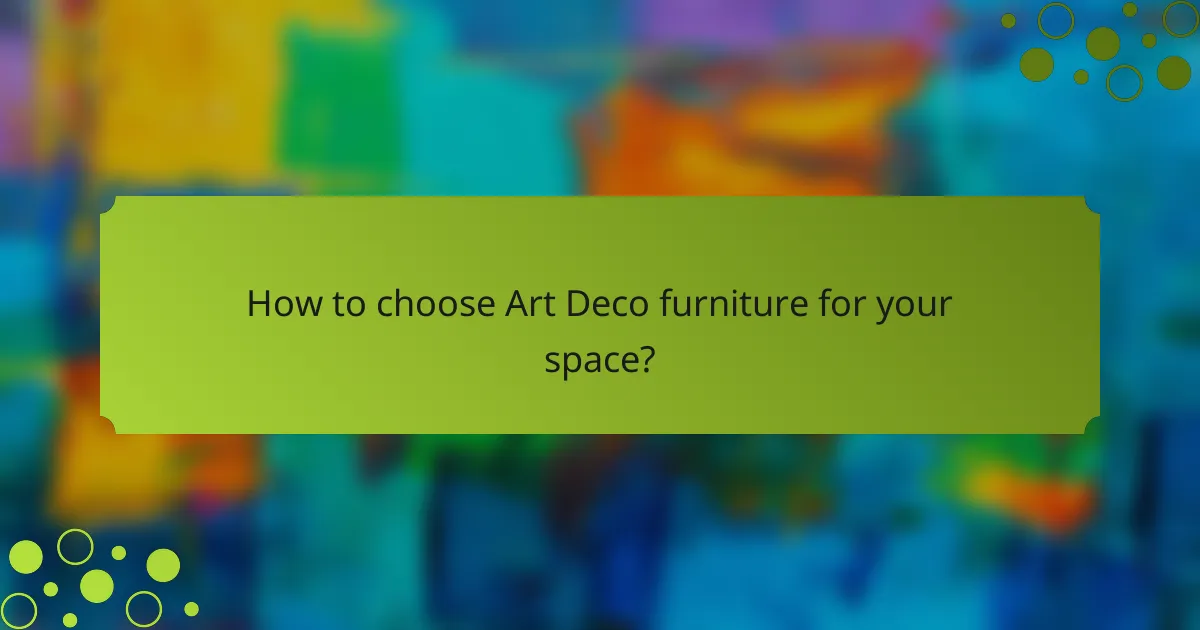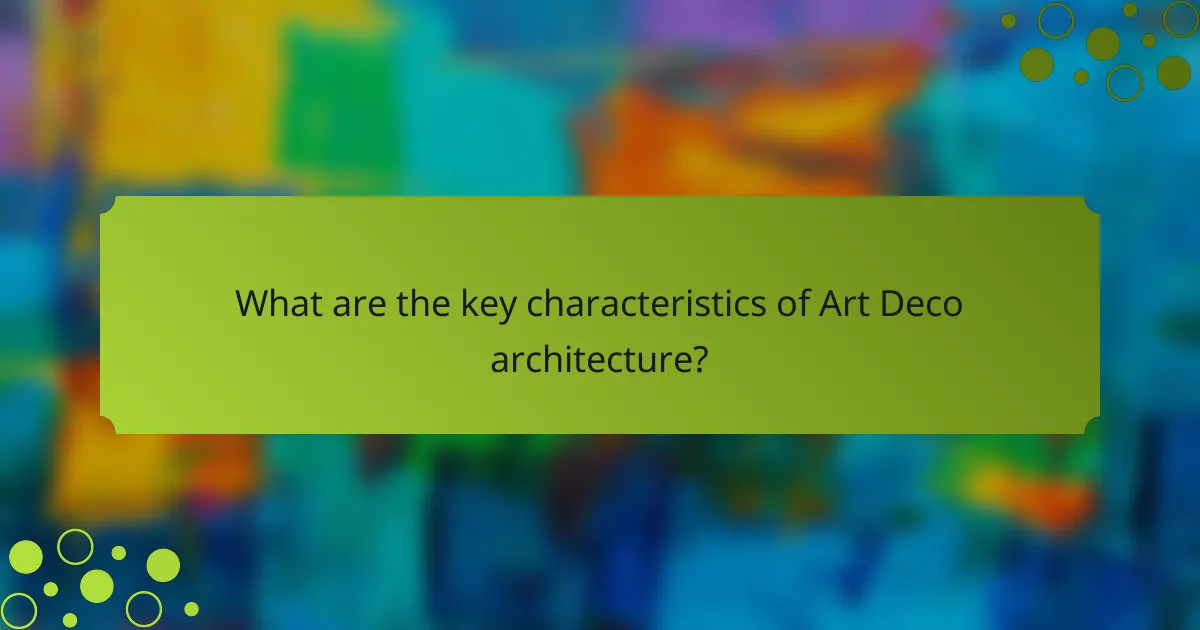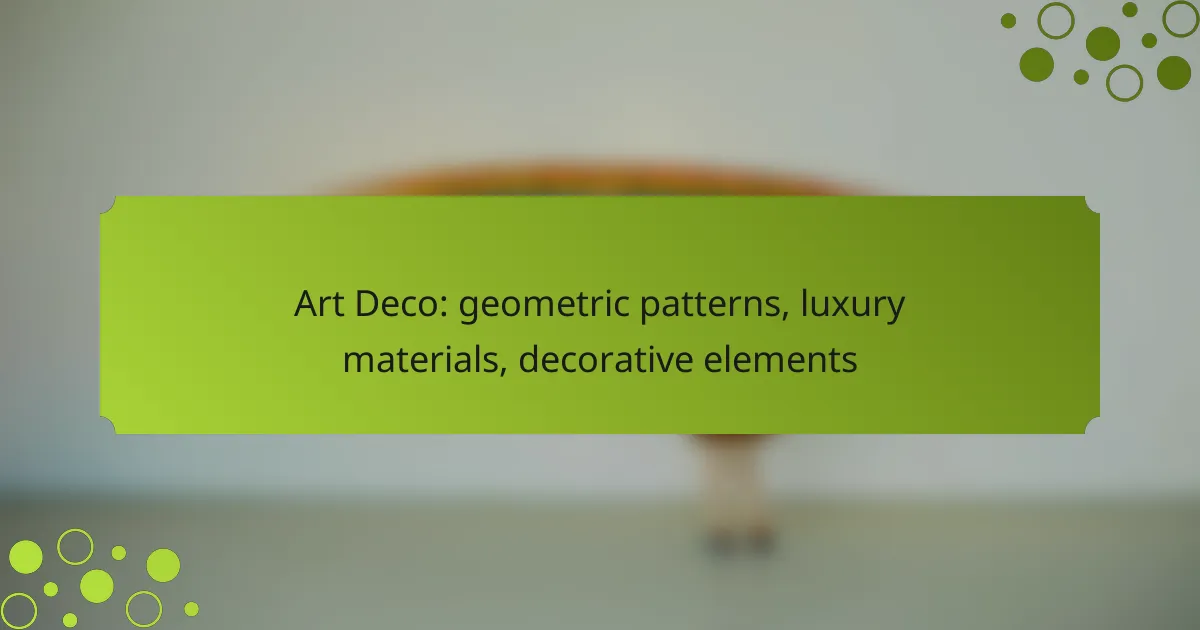Art Deco is a design movement celebrated for its bold geometric patterns and luxurious materials, creating an atmosphere of sophistication and elegance. Characterized by the use of opulent elements such as marble, brass, and glass, this style integrates decorative features like ornate lighting and stylized motifs to enhance any space. By thoughtfully incorporating these distinctive elements, one can achieve a timeless and glamorous aesthetic that defines the essence of Art Deco.

How to incorporate Art Deco geometric patterns in interior design?
Incorporating Art Deco geometric patterns in interior design involves using bold shapes, luxurious materials, and striking colors to create a sophisticated atmosphere. Focus on integrating these elements thoughtfully to enhance the overall aesthetic of your space.
Use bold shapes and lines
Art Deco is characterized by its bold geometric shapes and strong lines. Incorporate elements such as zigzags, chevrons, and sunburst motifs in your design to evoke the style’s essence. Consider using these shapes in architectural details, furniture, or decorative accents.
When selecting items, look for pieces that feature strong silhouettes and sharp angles. For example, a coffee table with a geometric base can serve as a focal point in your living room while embodying the Art Deco style.
Integrate contrasting colors
Contrasting colors are essential in Art Deco design, creating visual interest and depth. Pair rich hues like deep blues, emerald greens, or burgundy with metallics such as gold or silver to achieve a luxurious look. These combinations can be used in wall colors, furniture, and accessories.
When choosing a color palette, aim for a balance between bold and neutral tones. For instance, a striking navy wall can be complemented with gold-framed mirrors and white furniture, enhancing the overall Art Deco feel.
Apply patterns on wallpapers
Wallpaper featuring Art Deco patterns can dramatically transform a space. Look for designs that showcase geometric shapes, stylized florals, or metallic finishes to create a stunning backdrop. These wallpapers can be used in living areas, dining rooms, or even bedrooms.
Consider using wallpaper on a single accent wall to avoid overwhelming the room. This approach allows the geometric patterns to stand out while maintaining a cohesive design throughout the space.
Utilize geometric furniture
Geometric furniture is a hallmark of Art Deco design, offering both function and style. Seek out pieces with angular forms, such as side tables with hexagonal tops or chairs with curved lines. These elements can enhance the overall aesthetic while providing practical use.
When selecting furniture, prioritize quality materials like polished wood, glass, or metal to reflect the luxury associated with Art Deco. A statement piece, such as a geometric bookshelf, can serve as both storage and an eye-catching design element.
Incorporate Art Deco textiles
Textiles play a crucial role in achieving an Art Deco look. Use fabrics with geometric patterns, rich textures, or metallic threads for cushions, curtains, and upholstery. Velvet, silk, and brocade are excellent choices that add a touch of luxury to your decor.
Mix and match different textiles while keeping a cohesive color palette. For example, pairing a geometric print cushion with a solid velvet sofa can create a sophisticated contrast that embodies the Art Deco style.

What luxury materials define Art Deco style?
Art Deco style is characterized by the use of luxurious materials that enhance its geometric patterns and decorative elements. Key materials include marble, brass, glass, wood veneers, and leather, each contributing to the opulence and sophistication of the design.
Marble and granite
Marble and granite are quintessential materials in Art Deco architecture and design, known for their durability and elegance. These stones often feature bold veining and rich colors, making them ideal for flooring, countertops, and decorative accents.
When selecting marble or granite, consider the finish; polished surfaces reflect light beautifully, while honed finishes offer a more subdued look. Popular choices include Carrara marble and black granite, which can elevate the overall aesthetic of a space.
Brass and chrome
Brass and chrome are metals that embody the luxurious feel of Art Deco, often used in fixtures, furniture, and decorative elements. Brass, with its warm tone, adds a vintage charm, while chrome offers a sleek, modern touch.
Incorporating these metals can be done through light fixtures, cabinet hardware, or furniture legs. Ensure a balance between the two; for instance, pairing brass with darker woods can create a striking contrast that enhances the Art Deco style.
Glass and mirrors
Glass and mirrors play a vital role in Art Deco, often used to create depth and reflect light within a space. Decorative glass pieces, such as etched or colored glass, add intricate details, while mirrors can amplify the luxurious ambiance.
Consider using mirrored furniture or wall panels to enhance the sense of space. Be mindful of placement; mirrors should reflect beautiful views or art pieces to maximize their impact.
Wood veneers
Wood veneers are essential in Art Deco for adding warmth and texture to interiors. Exotic woods like mahogany, walnut, and ebony are commonly used, often showcasing intricate patterns that align with the geometric themes of the style.
When choosing wood veneers, look for high-quality finishes that highlight the natural grain. They are often applied to furniture surfaces, cabinetry, and wall panels, providing a rich contrast to the more reflective materials like glass and metal.
Leather and silk
Leather and silk are luxurious textiles that complement the Art Deco aesthetic, often used in upholstery and drapery. Leather provides durability and a classic look, while silk adds a touch of elegance and softness.
For upholstery, opt for rich colors like deep burgundy or emerald green to enhance the overall design. When using silk, consider it for curtains or decorative pillows to introduce a layer of sophistication and texture in the space.

What decorative elements are essential in Art Deco?
Essential decorative elements in Art Deco include stylized motifs, ornate lighting fixtures, elaborate mirrors, geometric rugs, and decorative wall panels. These elements combine to create a luxurious and sophisticated aesthetic that defines the Art Deco style.
Stylized motifs and sculptures
Stylized motifs and sculptures are central to the Art Deco aesthetic, often featuring geometric shapes and bold lines. Common themes include flora, fauna, and human figures, rendered in a simplified, abstract manner. When selecting motifs, consider how they can enhance the overall design without overwhelming the space.
Ornate lighting fixtures
Ornate lighting fixtures are crucial for achieving the glamorous look of Art Deco interiors. These fixtures often incorporate materials like chrome, glass, and crystal, featuring geometric designs or intricate detailing. Opt for statement pieces such as chandeliers or sconces that serve as focal points while providing adequate illumination.
Elaborate mirrors
Elaborate mirrors in Art Deco designs often feature decorative frames with geometric patterns or metallic finishes. They not only serve a functional purpose but also enhance the sense of space and light in a room. When choosing mirrors, look for unique shapes and embellishments that complement other decorative elements.
Geometric rugs
Geometric rugs are a hallmark of Art Deco style, often showcasing bold patterns and vibrant colors. These rugs can anchor a room and add warmth while reinforcing the geometric theme prevalent in Art Deco design. When selecting a rug, consider the scale of the pattern in relation to the room size to maintain balance.
Decorative wall panels
Decorative wall panels can transform a space, adding texture and visual interest in an Art Deco setting. These panels may feature materials like wood, metal, or plaster, often adorned with geometric designs or reliefs. When incorporating wall panels, ensure they harmonize with other elements to create a cohesive look.

How to choose Art Deco furniture for your space?
Choosing Art Deco furniture involves selecting pieces that embody geometric patterns, luxury materials, and decorative elements characteristic of the style. Focus on iconic designs that enhance your space while ensuring they fit your aesthetic and functional needs.
Focus on iconic brands like Baker Furniture
When selecting Art Deco furniture, consider renowned brands such as Baker Furniture, which are known for their quality craftsmanship and authentic designs. These brands often incorporate rich materials like mahogany, chrome, and glass, which are hallmarks of the Art Deco movement.
Investing in pieces from iconic manufacturers not only elevates the style of your space but also often ensures better durability and resale value. Look for signature styles that reflect the geometric and luxurious aspects of Art Deco.
Consider vintage vs. modern reproductions
Decide between vintage Art Deco pieces and modern reproductions based on your budget and design goals. Vintage items can offer unique character and history, but they may require more maintenance and careful sourcing to ensure authenticity.
Modern reproductions, on the other hand, can provide the same aesthetic with the benefit of contemporary materials and construction techniques. They often come at a lower price point and may be easier to find, making them a practical choice for many homeowners.
Evaluate comfort and functionality
While aesthetics are crucial in Art Deco furniture, comfort and functionality should not be overlooked. Ensure that chairs, sofas, and tables not only look good but also serve your daily needs effectively.
Test pieces for comfort and consider how they will fit into your lifestyle. For example, a beautifully designed chair should also provide adequate support for long periods of use. Always balance style with practical usability to create a harmonious living space.

What are the key characteristics of Art Deco architecture?
Art Deco architecture is defined by its geometric patterns, luxurious materials, and decorative elements. This style emerged in the early 20th century, combining modernist styles with rich ornamentation, creating a sense of elegance and sophistication.
Geometric Patterns
Geometric patterns are a hallmark of Art Deco architecture, featuring bold shapes and symmetrical designs. These patterns often include zigzags, chevrons, and stylized floral motifs, which contribute to the overall visual impact of buildings.
When incorporating geometric patterns, consider the scale and repetition to maintain harmony. For instance, large buildings may use expansive motifs, while smaller structures might opt for more intricate detailing.
Luxury Materials
Art Deco architecture prominently features luxury materials such as marble, chrome, glass, and exotic woods. These materials enhance the opulence of the design and are often used in both structural and decorative elements.
For example, polished marble can be used for flooring and wall finishes, while chrome accents may highlight railings or fixtures. When selecting materials, aim for high-quality options that reflect the grandeur associated with this style.
Decorative Elements
Decorative elements in Art Deco architecture include intricate carvings, relief sculptures, and ornamental motifs. These embellishments are strategically placed to enhance the aesthetic appeal without overwhelming the overall design.
Common decorative features include stylized animals, sunbursts, and fluted columns. When designing, ensure that these elements complement the geometric patterns and luxury materials to create a cohesive look.
